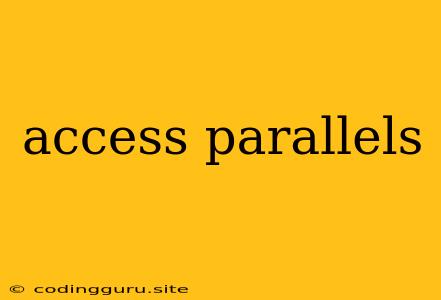Accessing Parallels: A Comprehensive Guide
Parallels Desktop is a popular virtualization software that allows you to run different operating systems (OS) on your computer simultaneously. It's a powerful tool for developers, designers, and anyone who needs to use multiple OS for work or personal use. But getting access to Parallels can sometimes be a bit confusing.
This article will answer your questions about accessing Parallels, whether you're a new user or an experienced one. We'll cover different aspects, from downloading and installing to accessing your virtual machines and utilizing its features.
How do I access Parallels Desktop?
The first step to accessing Parallels Desktop is to download and install it on your computer. You can find the installer for your specific operating system on the Parallels website. Once downloaded, run the installer and follow the on-screen instructions.
Tip: Make sure your computer meets the minimum system requirements for Parallels Desktop before attempting to download and install it.
What is the process of getting started with Parallels?
Once you have Parallels Desktop installed, you can start creating virtual machines (VMs). A VM is essentially a virtual computer running inside your host computer.
To create a VM:
- Open Parallels Desktop.
- Click "Create" on the welcome screen or in the menu bar.
- Select the operating system you want to install. Parallels Desktop supports a wide range of operating systems, including Windows, macOS, Linux, and more.
- Choose a name and location for your VM.
- Select the size of the hard disk for your VM.
- Follow the on-screen instructions to complete the installation process.
How can I access my existing virtual machines?
After creating a VM, you can easily access it from the Parallels Desktop window. You'll find a list of your VMs on the left side of the screen. Simply click on the VM you want to access, and it will start running in a window on your desktop.
Tip: You can customize the way your VMs appear on your desktop by adjusting the display settings in Parallels Desktop.
What are some useful Parallels features?
Parallels Desktop offers many features to enhance your experience with virtual machines. Some of these features include:
- Copy and Paste: You can easily copy and paste text, images, and files between your host computer and your virtual machines.
- Drag and Drop: This allows you to drag and drop files between your host computer and your virtual machines.
- Shared Folders: You can share folders between your host computer and your virtual machines, making it easy to access files from both systems.
- Full-Screen Mode: This allows you to run your VM in full-screen mode, giving you the feeling of using the virtual machine as your primary operating system.
- Coherence Mode: This mode allows you to run your VM's applications directly on your host computer's desktop, as if they were native applications.
Can I use Parallels to access my other computers?
Yes, you can use Parallels Desktop to remotely access other computers. This feature is called Parallels Access.
To use Parallels Access:
- Install Parallels Access on your host computer.
- Install the Parallels Access agent on the computer you want to access remotely.
- You can then connect to your remote computer through the Parallels Access app.
Are there any limitations to accessing Parallels?
While Parallels Desktop is a powerful tool, there are some limitations to keep in mind:
- Performance: Using virtual machines can sometimes affect the performance of your host computer. This is especially true if you are running resource-intensive applications in your VMs.
- Compatibility: Not all software is compatible with virtual machines. You may need to check for compatibility before installing software on your VMs.
- Licensing: Parallels Desktop is a paid software, and you will need to purchase a license to use it.
How can I access Parallels Desktop on my mobile device?
Parallels Desktop is primarily designed for use on desktop computers. However, you can access your VMs remotely using Parallels Access, which is available on iOS and Android devices.
What are some common issues with accessing Parallels?
If you're experiencing problems accessing Parallels Desktop, here are some common issues and solutions:
- Parallels Desktop won't start: Check to make sure that Parallels Desktop is installed correctly and that your computer meets the minimum system requirements.
- Virtual machine won't start: Try restarting your computer and your VM. You can also try reinstalling the operating system on your VM.
- Performance issues: If you are experiencing slow performance, you may need to increase the amount of RAM allocated to your VM or adjust other settings.
Where can I find more help with accessing Parallels?
The Parallels website offers comprehensive documentation, tutorials, and support resources to help you with accessing and using Parallels Desktop. You can also find helpful information and support from the Parallels community forums.
Conclusion
Parallels Desktop is a powerful and versatile tool for accessing multiple operating systems on your computer. By following the instructions and tips outlined in this article, you can easily access and use Parallels to enhance your work and personal productivity. Remember that while it's a robust tool, it's important to consider its limitations and seek assistance when needed. This guide provides a comprehensive starting point for understanding and navigating the world of Parallels.
